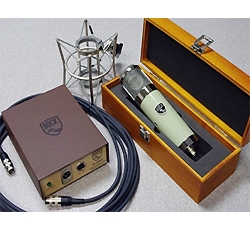There are a few people on the planet that know a lot about microphones and how they’re made, but not many know as much and have the dedication of David Bock, the founder and owner of Bock Audio (formerly Soundelux Microphones).
After all, how many people would go to the extent of teaching themselves German just so they could read the old Neumann service manuals? David makes some truly excellent mics, and you’ll see a little of just how that came to pass with this excerpt from The Recording Engineer’s Handbook.
————————————————————————————————————-
After stints repairing microphones (among other things) at such prestigious facilities as the Hit Factory and Oceanway, Bock Audio (formerly Soundelux) founder and managing director David Bock went from repairing vintage microphones to manufacturing them. David now utilizes his expertise to produce updated versions of the studio classic 251, Although he previously made versions of the U47, FET47, M49 and U67 in the previous Soundelux incarnation of the company. David was kind enough to share some of his insights as to the inner workings and differences between classic microphones and their modern counterparts.
What actually makes a vintage microphone so special?
There are a couple of things that go into that. The bottom line is that the 50’s were really the golden age of audio design. Those guys really did know what they were doing when they designed a lot of the key gear that people are still using. They used a lot of the correct techniques and they had the luxury of decent materials and the time to research things properly.
There is a tone to these things that is harder and harder to duplicate. Not impossible, just harder and harder. They had tubes back then that are harder to get now. The available selection of materials was a lot greater back then. Then there’s the element of chance. Why would someone pay $20,000 for a 251? Well, maybe that particular 251 really does sound unique because AKG’s production was so sloppy and the capsules were so poorly machined that you’re bound to get one that excels beyond everything else and the rest are just kind of average. Now we have CNC machines that can make these tiny little holes on the capsule backplate all the same, which AKG really couldn’t do.
As you were trying to build an updated version of a vintage microphone, were you trying to copy everything including the circuitry and trying to get it as close to the original as possible, or were you trying to just make it sound like the original?
The sound comes first but that’s not the whole story. The first thing I had to do was try to find what makes the microphone sound the way it does. There were at least 15 points that you have to look at, it turns out, if you’re going to emulate the sound of a microphone. The first large problem is “I want to copy the sound of a 251”. Well, which 251? I rented about ten 251s here in town (Hollywood) and you know what? There’s no such thing as a common 251. They’re all totally different. I could hear it and I could measure it.
Among some of them there is a common thread though. Frequency response is the primary guidepost because all microphones have their own signature. But frequency response curves don’t always tell you everything. You have to take frequency response measurements not only far-field but also proximity (near-field), which strangely are not published and are completely critical to what we believe a microphone sounds like in the directional world. That’s key and it’s somewhat of a disservice that most of the larger condenser microphone manufacturers have not been publishing those graphs for many years.
That’s why most engineers will say “Those graphs don’t really mean anything”. That’s because you’re always looking at a 1 meter graph but you’re not always putting your microphone 1 meter away from the sound source. So of course they don’t mean anything because they’re not telling you what you’re hearing. If you saw a proximity graph and a 1 meter graph you’d have a much better idea of what the microphone sounds like.





















